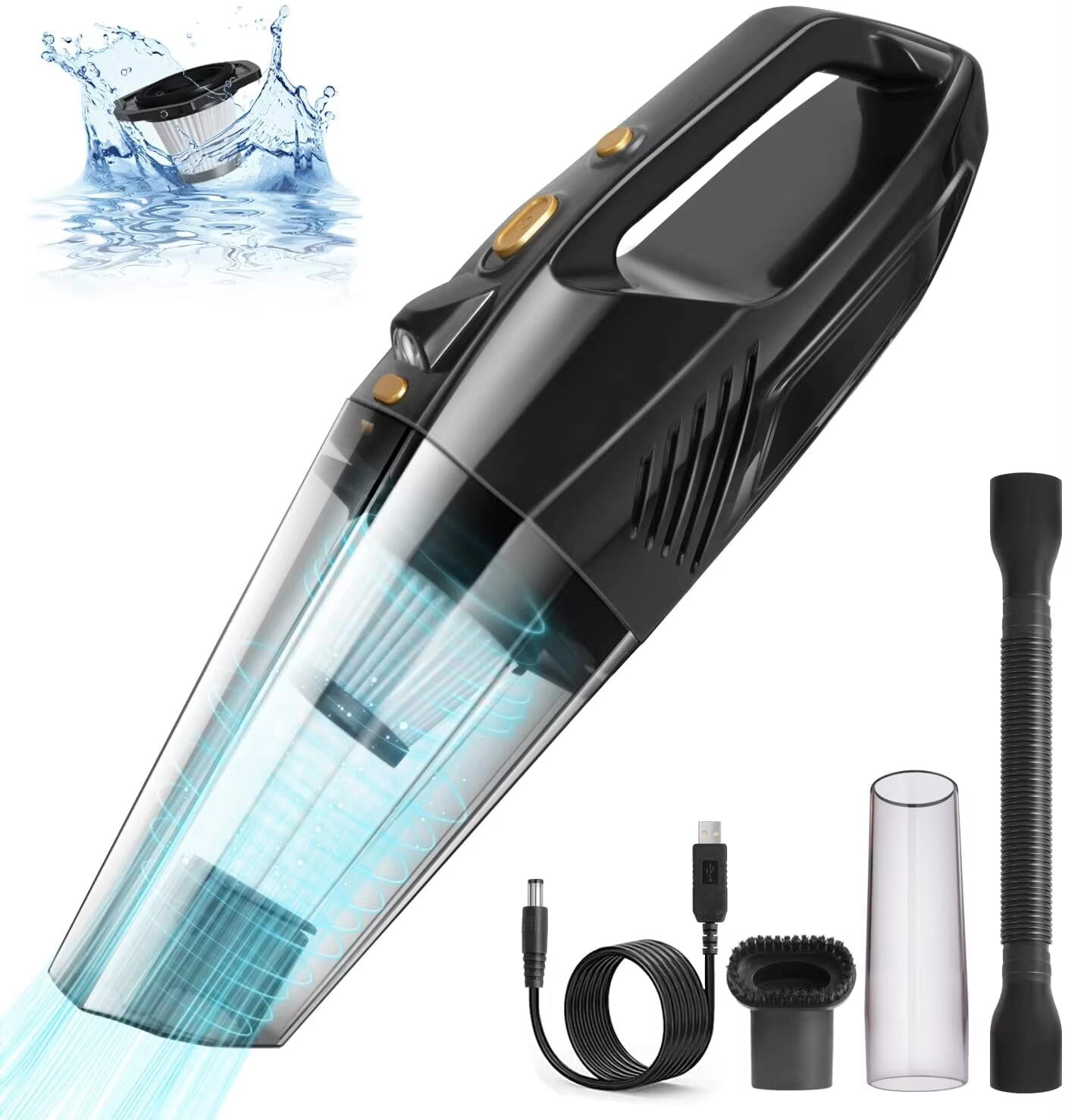الميزات الأساسية لمنظفات السيارات الحديثة
تحتاج صيانة مقصورة سيارتك نظيفة وعطرية إلى الأدوات المناسبة، ويأتي منظف السيارة الكهربائي في مقدمة أدوات الصيانة الفعالة. سواء كنت تتعامل مع الحطام اليومي، أو شعر الحيوانات الأليفة، أو تلك الفتات العنيدة التي تبدو وكأنها تتضاعف بين المقاعد، فإن اختيار منظف سيارة مناسب يمكن أن يحول روتين التنظيف الخاص بك من مهمة مرهقة إلى مهمة سريعة وممتعة.
تأتي منظفات السيارات اليوم مزودة بميزات مبتكرة تم تصميمها خصيصًا للبيئات السيارات. من قدرات شفط قوية إلى أدوات متخصصة، تطورت هذه الأجهزة لتلبية التحديات الفريدة في تنظيف مقصورات السيارات. وفهم هذه الميزات أمر بالغ الأهمية لاتخاذ قرار شراء مدروس يتماشى مع احتياجاتك الخاصة.
فهم أنواع مختلفة من منظفات السيارات
منظفات سيارة مزودة بأسلاك كهربائية
توفر مكنسة السيارات ذات الكابل قوة كهربائية ثابتة ووقت تشغيل غير محدود، مما يجعلها مثالية لجلسات التنظيف الشاملة. عادةً ما توفر هذه الموديلات شفطًا أقوى مقارنة بالإصدارات بدون كابل، مما يضمن تنظيفًا عميقًا للسجاد والمقاعد. العامل الرئيسي الذي يجب مراعاته هو طول الكابل وتوفر مصدر الطاقة، حيث ستحتاج إلى التأكد من وجود منفذ كهربائي أو محول طاقة للسيارة.
تأتي العديد من مكائن تنظيف السيارات ذات الكابل بأسلاك ممتدة مصممة خصيصًا للوصول إلى جميع أنحاء السيارة. تعني هذه الطاقة الكهربائية المستمرة أنه لن تضطر إلى القلق بشأن عمر البطارية أثناء جلسات التنظيف الطويلة، مما يجعلها مناسبة بشكل خاص لمصممي التفاصيل الاحترافيين أو الأشخاص الذين يديرون عدة مركبات.
مكنسة تنظيف السيارات بدون كابل
المنظفات الكهربائية المحمولة للسيارات بدون أسلاك توفر حرية الحركة والسهولة في الاستخدام. هذه الوحدات التي تعمل بالبطاريات مناسبة تمامًا للتنظيف السريع والصيانة الدورية. توفر بطاريات الليثيوم أيون الحديثة عمر تشغيل أطول وأداءً أكثر استقرارًا مقارنة بالطرز الأقدم، على الرغم من أنك ستحتاج إلى أخذ عمر البطارية وزمن الشحن بعين الاعتبار أثناء عملية الاختيار.
تأتي راحة التشغيل بدون أسلاك مع بعض الاعتبارات المتعلقة بإدارة الطاقة والبنية التحتية للشحن. تقدم العديد من النماذج الحالية خاصية الشحن السريع ومؤشرات لمستوى البطارية لمساعدتك في إدارة جلسات التنظيف بشكل فعال. تحتوي بعض النماذج الفاخرة حتى على بطاريات قابلة للإزالة، مما يسمح بتمديد فترة الاستخدام باستخدام حزم طاقة إضافية.
عوامل الأداء الرئيسية التي يجب أخذها بعين الاعتبار
قوة الشفط وكفاءة المحرك
إن القلب النابض لأي مكنسة كهربائية للسيارة هو قدرتها على الشفط، والتي تتحدد بقوة المحرك وكفاءة التصميم. فكلما زادت القدرة بالواط، زادت قوة الشفط عمومًا، لكن المحركات الحديثة يمكنها تقديم أداء متميز مع الحفاظ على كفاءة استهلاك الطاقة. ابحث عن الموديلات التي تحدد قوتها في الشفط بوحدة الواط الهوائي أو الكيلوباسكال لتسهيل المقارنة بدقة.
تعمل أنظمة الترشيح المتطورة بالتزامن مع المحرك لضمان استمرارية قوة الشفط طوال عملية التنظيف. فالترشيل المتعدد المراحل لا يضمن التقاط الأوساخ بشكل أفضل فحسب، بل يساعد أيضًا في تقليل إجهاد المحرك وبالتالي إطالة عمر الجهاز. ضع في الاعتبار الموديلات ذات التصميم الدوراني، والتي تساعد في فصل الجسيمات الكبيرة عن الغبار الدقيق، مما يحافظ على الأداء الأمثل لقوة الشفط.
جودة نظام الترشيح
إن نظام الترشيح الفائق ضروري لاحتجاز الجسيمات الدقيقة ومنعها من إعادة التدوير داخل مقصورة مركبتك. وقد أصبحت مرشحات HEPA هي المعيار الذهبي، حيث تلتقط 99.97% من الجسيمات بحجم 0.3 ميكرون. إن هذا المستوى من الترشيح مهم بشكل خاص لمن يعانون من الحساسية وأولئك القلقين بشأن جودة الهواء.
إن الصيانة الدورية لنظام الترشيح تضمن الأداء المتسق وطول عمر مكنسة السيارة الخاصة بك. ابحث عن الموديلات التي تحتوي على مرشحات سهلة الوصول وقابلة للغسل لتقليل تكاليف الصيانة المستمرة وضمان كفاءة التنظيف على المدى الطويل.
عناصر التصميم العملية
تنوع الملحقات
إن الإكسسوارات المناسبة تحول مكنسة السيارة الأساسية إلى أداة تنظيف متعددة الاستخدامات. تتضمن الإكسسوارات الأساسية أدوات الشقوق للوصول بين المقاعد وفواصل التابلوه، وإكسسوارات الفرشاة لتغطية المقاعد ومنافث الهواء، وقضبان التمديد لتحسين مدى الوصول. ضع في اعتبارك حلول التخزين لهذه الإكسسوارات، بالإضافة إلى متانتها وسهولة التبديل بين الأدوات.
تقدم بعض الموديلات الفاخرة إكسسوارات متخصصة مثل أدوات إزالة شعر الحيوانات الأليفة أو فرش ناعمة لتنظيف الأسطح الحساسة. يجب تقييم جودة وصلات الإكسسوارات وثباتها أثناء الاستخدام، إذ يمكن أن تؤثر الوصلات غير المحكمة بشكل كبير على فعالية التنظيف.
الاعتبارات أرجونوميكية
تلعب الراحة أثناء الاستخدام دورًا كبيرًا في تجربة التنظيف. تؤثر توزيع الوزن وتصميم المقبض ووضعية الأزرار على الراحة أثناء جلسات التنظيف الطويلة. خذ بعين الاعتبار وزن الجهاز الكلي، خاصة في الموديلات المحمولة التي تستخدمها في الأماكن الضيقة.
يجب أن يسمح التصميم بتفريغ حاوية الغبار بسهولة وإجراء عمليات الصيانة البسيطة دون عناء. ابحث عن الموديلات التي تحتوي على حاويات شفافة لمراقبة مستوى الأوساخ، وعن آليات إفراغ مريحة تسمح بالتفريغ دون فوضى أو تعقيد.
اتخاذ قرار الشراء النهائي
اعتبارات الميزانية
بينما تقدم مُجففات السيارات الفاخرة ميزات متقدمة وجودة تصنيع متفوقة، إلا أن هناك خيارات ممتازة متوفرة في مختلف المستويات السعرية. خذ في الاعتبار تكرار التنظيف والاحتياجات الخاصة بك عند تحديد ميزانيتك. في بعض الأحيان، قد يكون الاستثمار في وحدة عالية الجودة في البداية أكثر فعالية من حيث التكلفة على المدى الطويل من خلال المتانة والأداء.
خذ بعين الاعتبار التكاليف الإضافية مثل مرشحات الاستبدال والأكياس (إن وجدت) واحتمال استبدال البطارية للنماذج اللاسلكية. بعض الشركات المصنعة تقدم ضمانات ممتدة أو خطط صيانة قد تكون مفيدة عند النظر في النماذج الفاخرة.
مصداقية العلامة التجارية والدعم
غالبًا ما توفر العلامات التجارية المعروفة دعمًا أفضل للعملاء وإتاحة أسرع لقطع الغيار. قم بالاطلاع على شروط الضمان وسمعة خدمة العملاء وتوفر قطع الغيار الاستبدالية قبل اتخاذ قرارك النهائي. يمكن أن توفر التعليقات من المستخدمين والاختبارات الاحترافية رؤى قيمة حول الموثوقية والأداء على المدى الطويل.
خذ بعين الاعتبار سجل المصنّع في مجال منتجات التنظيف automotive والتزامه بالابتكار والتحسين المستمر للمنتج. يمكن أن يشير ذلك إلى احتمالية تلقيك دعمًا مستمرًا وتحديثات محتملة للبرمجيات لأنظمة النماذج الذكية.
الأسئلة الشائعة
ما هي المدة التي يجب أن أنظف فيها مرشح مكنسة السيارة؟
الصيانة الدورية لمرشح مكنسة السيارة ضرورية لتحقيق الأداء الأمثل. للاستخدام العادي، نظّف المرشح أو استبدله كل 1-2 شهور. ولكن، إذا كنت تستخدم المكنسة بشكل متكرر أو تقوم بتنظيف مناطق غبارية بشكل خاص، فقد يصبح التنظيف الشهري ضروريًا. اتبع دائمًا إرشادات الصيانة المحددة التي يوصي بها المصنّع لنموذجك.
ما هو مستوى الطاقة الكافي لتنظيف السيارات بشكل فعّال؟
لتنظيف فعال للسيارة، ابحث عن مكنسة كهربائية لتنظيف السيارات بقوة لا تقل عن 12 فولت لأنواع التيار المستمر ذات الكابل، أو 20 فولت لأنواع اللاسلكية. من حيث قوة الشفط، استهدف ما لا يقل عن 15-20 واط هواء. مع ذلك، تذكر أن الفعالية الفعلية في التنظيف تعتمد أيضًا على كفاءة التصميم وجودة الملحقات.
هل عليّ اختيار مكنسة رطبة/جافة لسيارتي؟
تقدم المكنسة الكهربائية الرطبة/الجافة مرونة إضافية، وهي مفيدة بشكل خاص لتنظيف الانسكابات أو بعد تنظيف تنجيد السيارة بالشامبو. وعلى الرغم من أن هذه الأنواع تكون عادةً أكثر تكلفة، إلا أنها توفر وظائف قيمة إذا كنت تتعامل بشكل متكرر مع فوضى سائلة أو تعيش في منطقة يتعرض فيها داخل سيارتك للمطر أو الثلج بانتظام.

